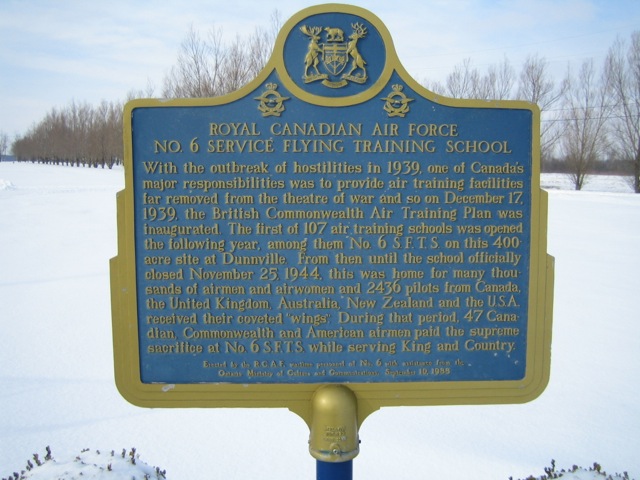Ontario's Historical Plaques
at ontarioplaques.com
Learn a little Ontario history as told through its plaques
Royal Canadian Air Force No. 6 Service Flying Training School

Photo by contributor Colin Semple - Posted February, 2008
Photo by contributor Wayne Adam - Posted October, 2010
Plaque Location
The County of Haldimand
On Port Maitland Road (Road 11)
about 4 km south of Highway 3
Coordinates: N 42 52.732 W 79 35.207 |
Plaque Text
With the outbreak of hostilities in 1939, one of Canada's major responsibilities was to provide air training facilities far removed from the theatre of war and so on December 17, 1939, the British Commonwealth Air Training Plan was inaugurated. The first of 107 air training schools was opened the following year, among them No. 6 S.F.T.S. on this 160 ha site at Dunnville. From then until the school officially closed November 25, 1944, this was home for many thousands of airmen and airwomen and 2436 pilots from Canada, the United Kingdom, Australia, New Zealand and the U.S.A. received their coveted "wings". During that period, 47 Canadian, Commonwealth and American airmen paid the supreme sacrifice at No. 6 S.F.T.S. while serving King and Country.
Related Ontario plaques
British Commonwealth Air Training Plan
RCAF Technical Training School
More
The Military
Here are the visitors' comments for this page.
Posted December 5, 2011
This plaque is unusual in that is doesn't appear to come from the Ontario Heritage Foundation, but uses its plaque design. A notation at the bottom says "Erected by the R.C.A.F. wartime personnel of No. 6 with assistance from the Ontario Ministry of Culture and Communications. September 10, 1988". While the Foundation likely came under the culture department in that era, its name would normally appear on a plaque. This suggests air force veterans may have circumvented the Foundation in getting this one erected, further supported by the addition of not one, but two air force crests, unheard of on a provincial plaque. Curiously, the reverse of this plaque is a completely blank blue field, save for the Ontario arms on top. The Foundation would have repeated the same text on both sides, and would soon make it policy to put a French version on one side. This is a rare, if not unique, example of a cooperative plaque (veterans and Culture, in this case) taking the form of a provincial historical plaque. Most if not all other cooperative plaques avoid use of the familiar blue marker design, one of the hallmarks of the Ontario Heritage Foundation (now Trust) which it may have subsequently decided to defend as a trademark.
-Wayne
Here's where you can write a comment for this page.
Note: If you wish to ask me a question, please use the email link in the menu.
Note: Comments are moderated. Yours will appear on this page within 24 hours
(usually much sooner).